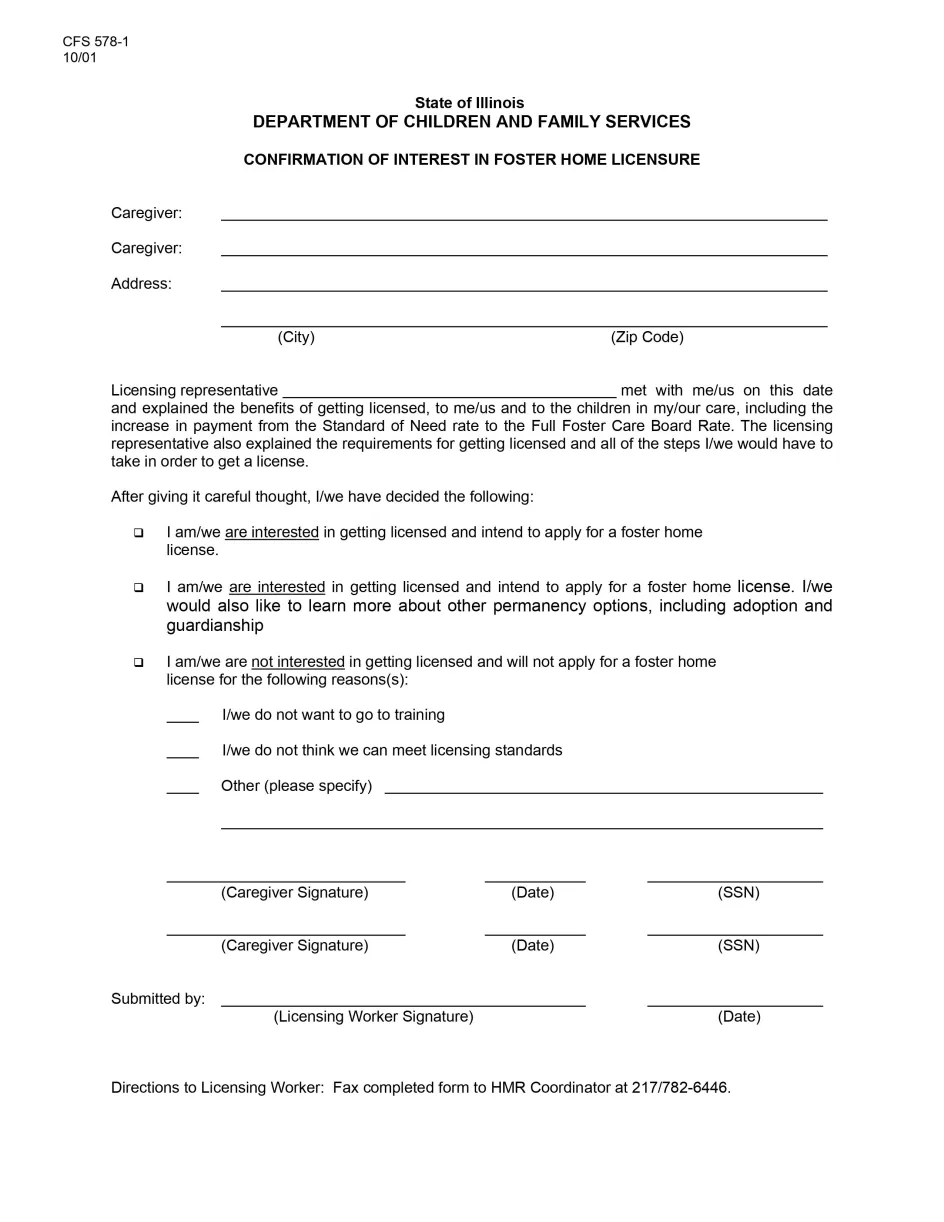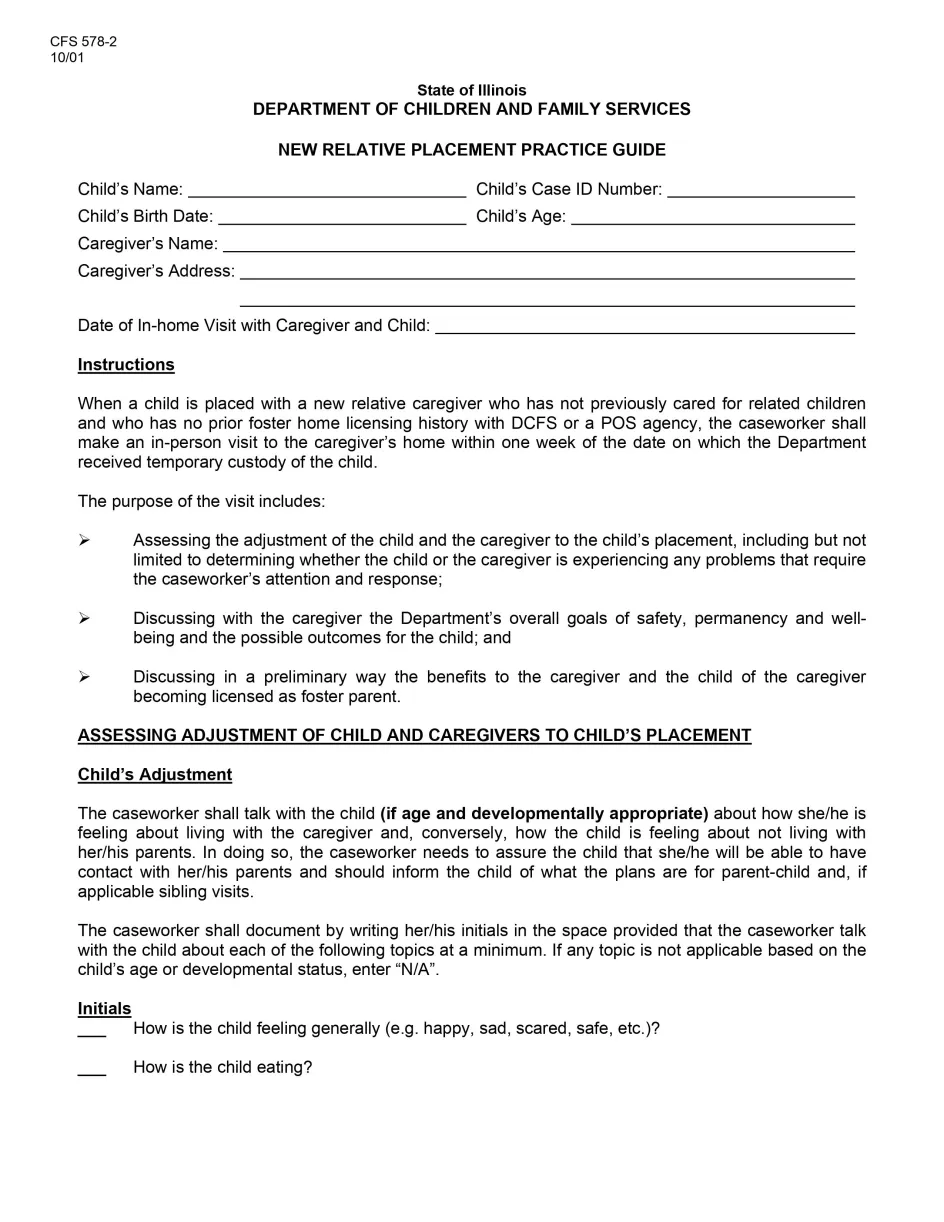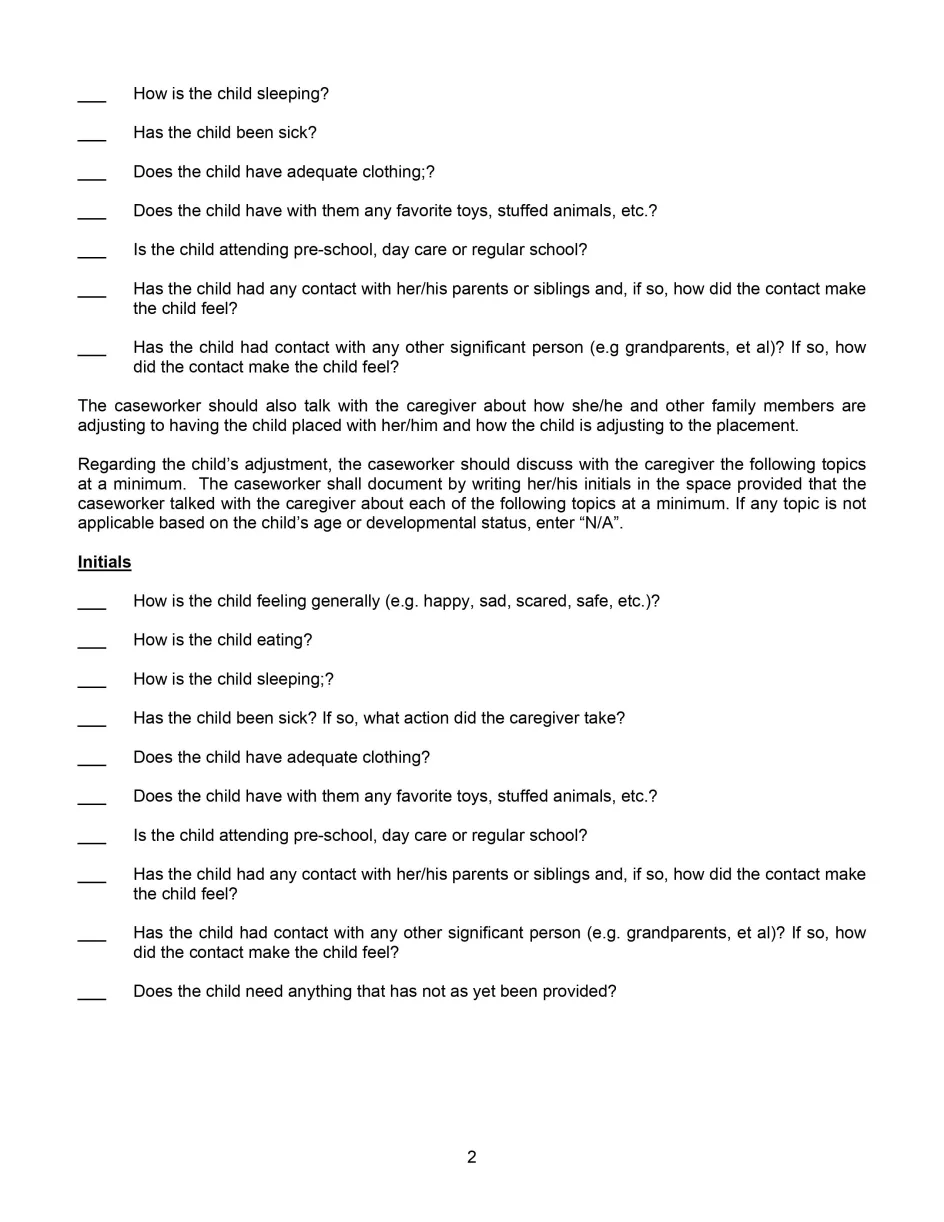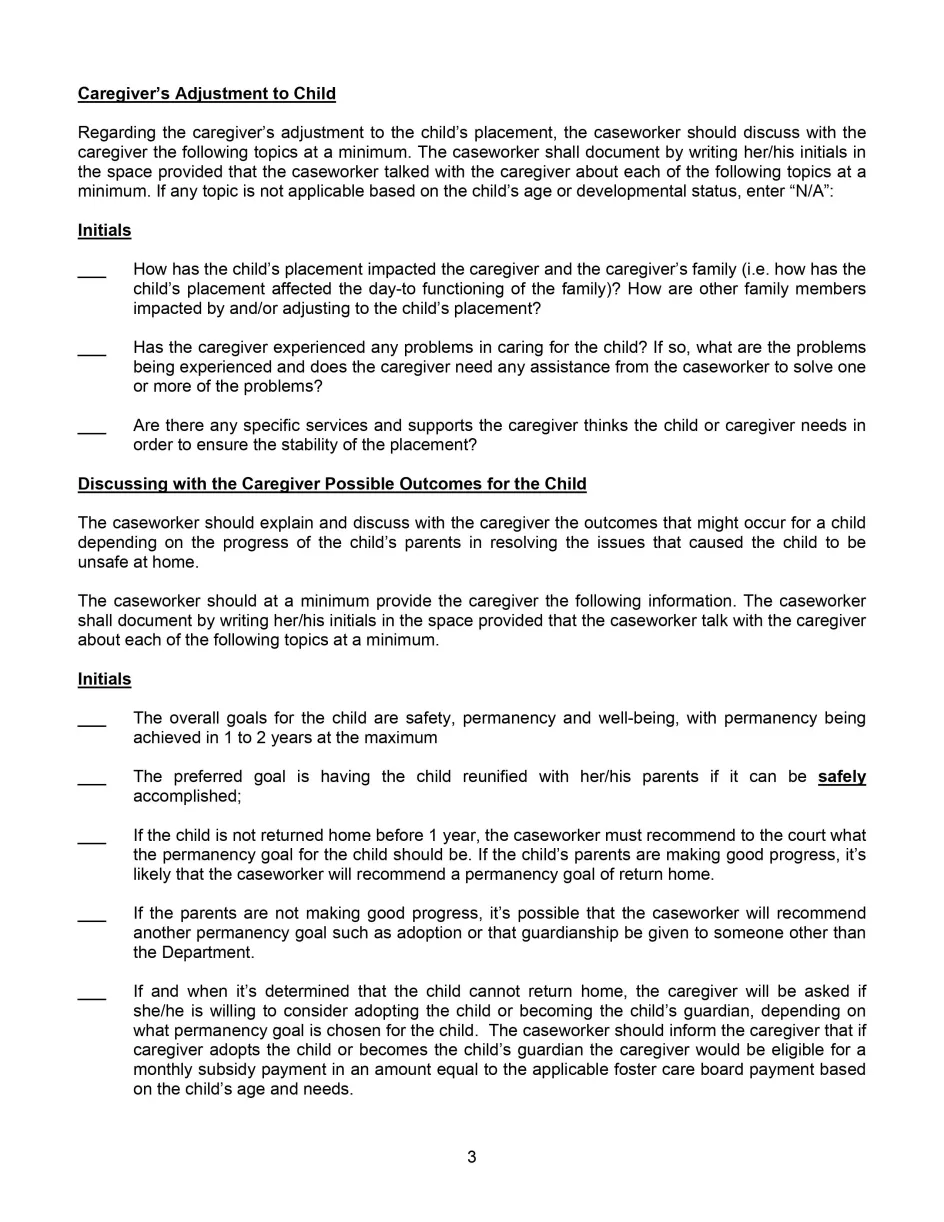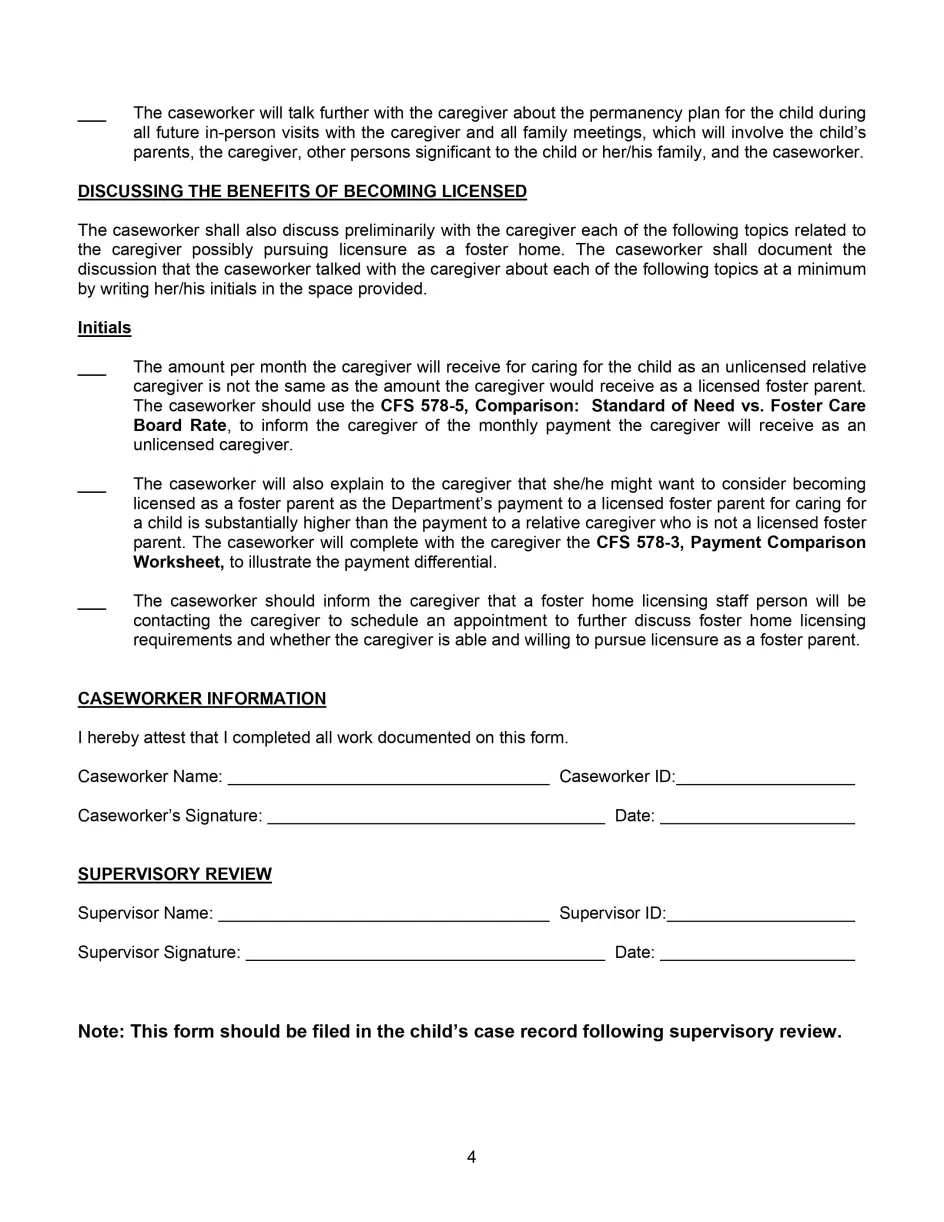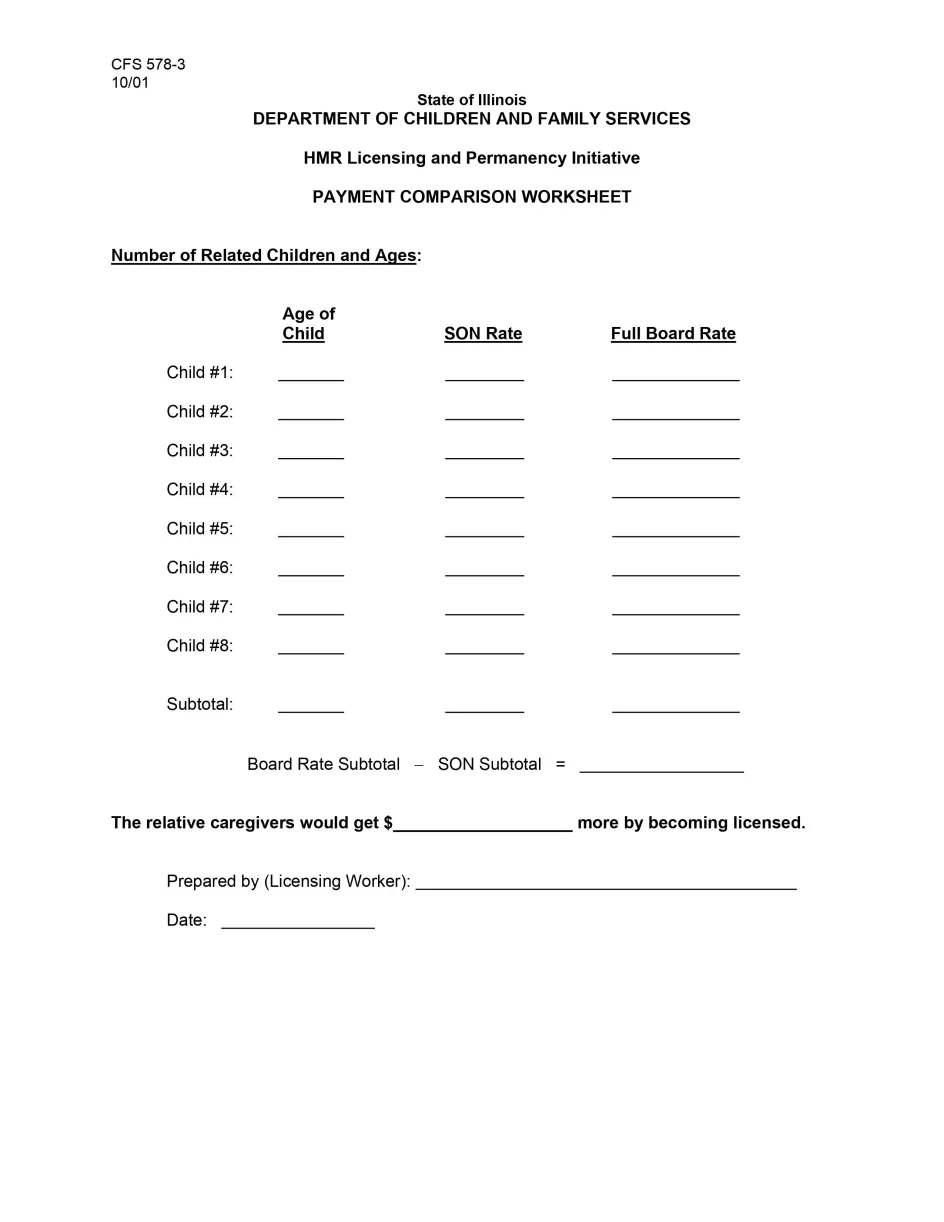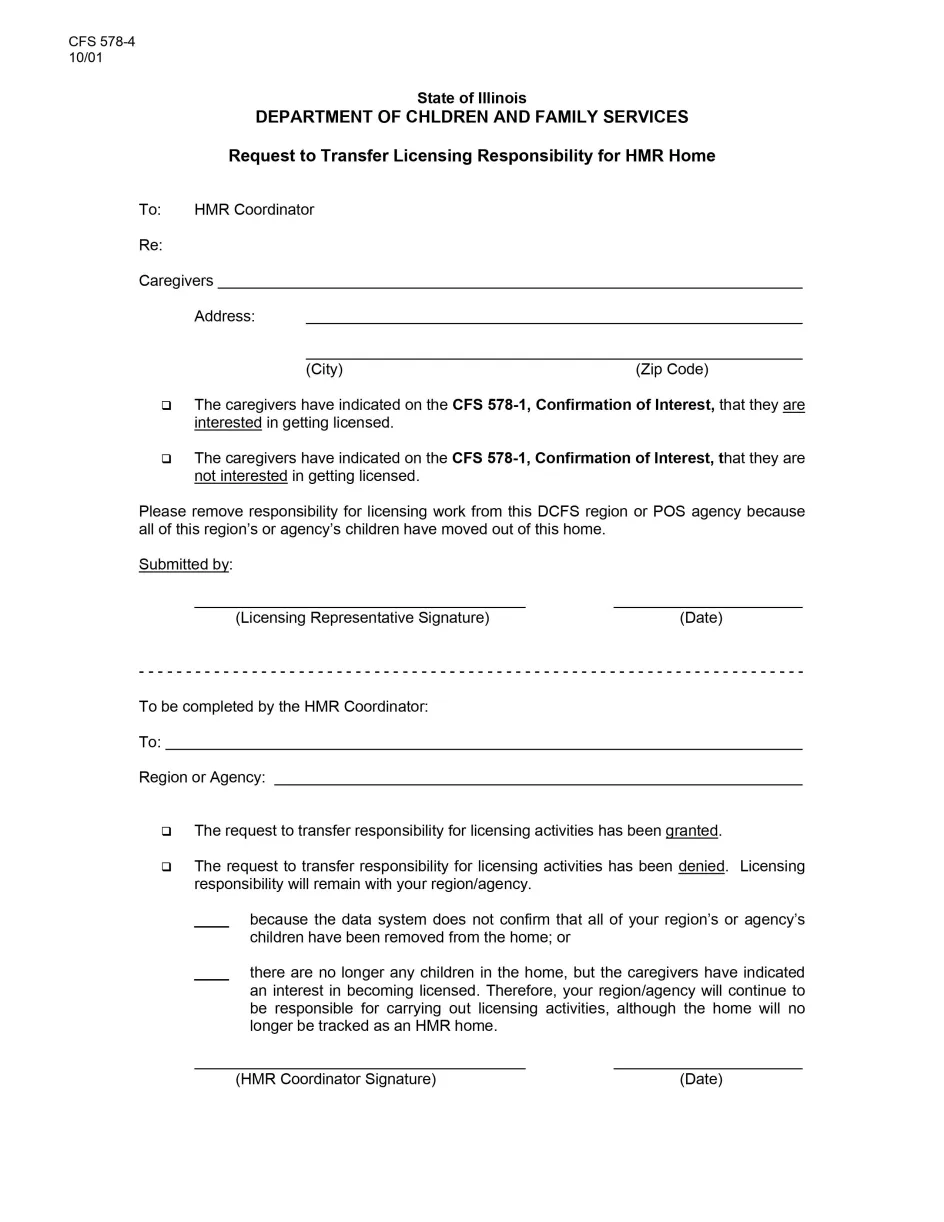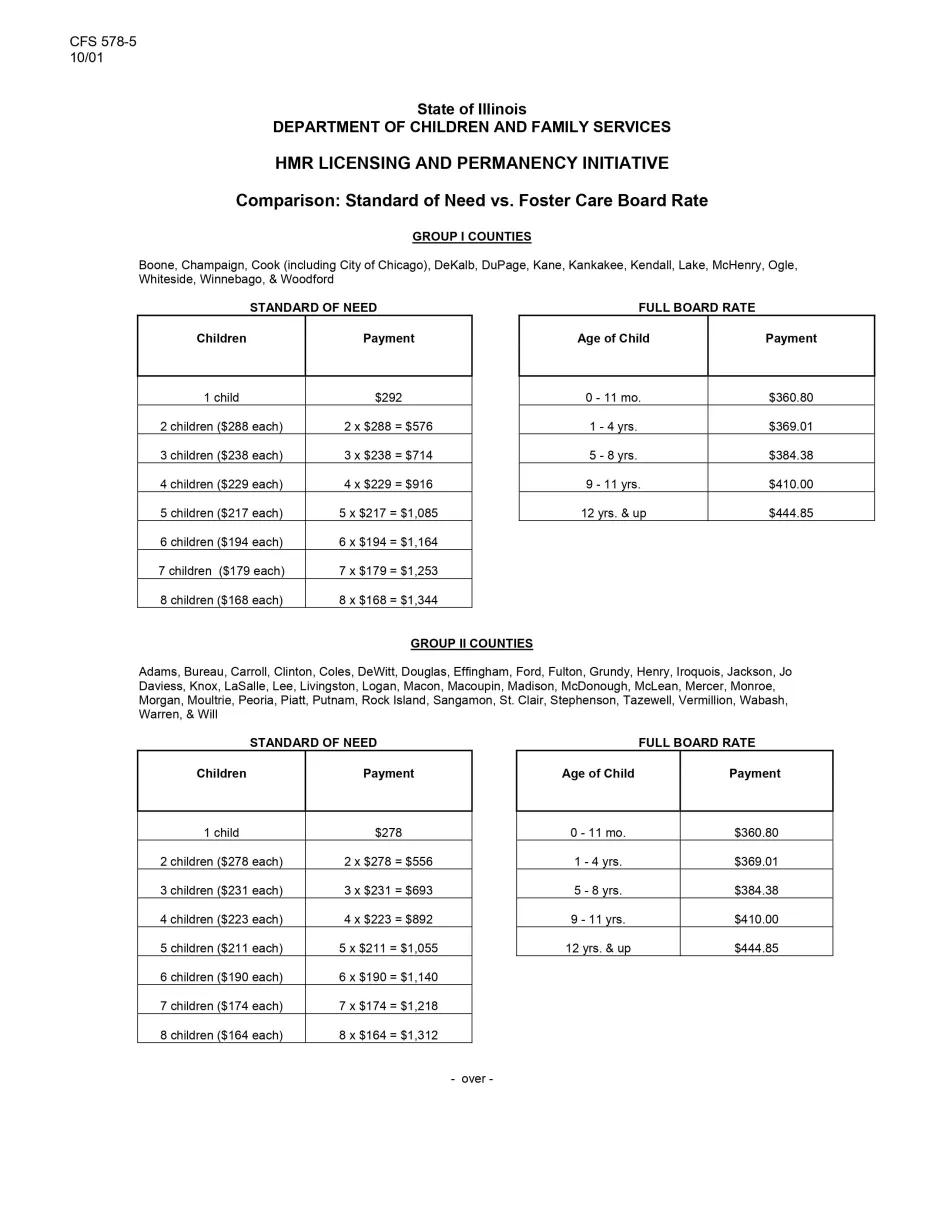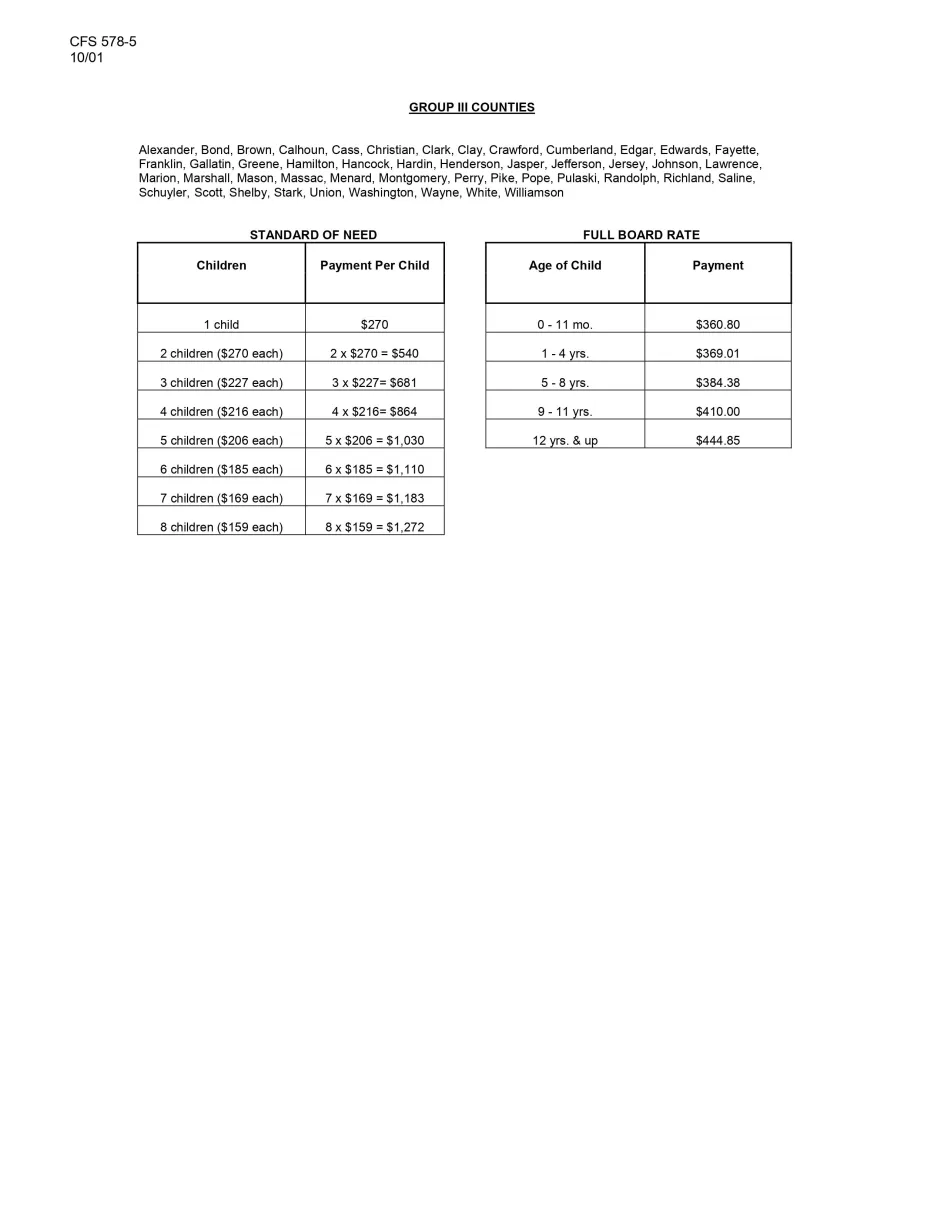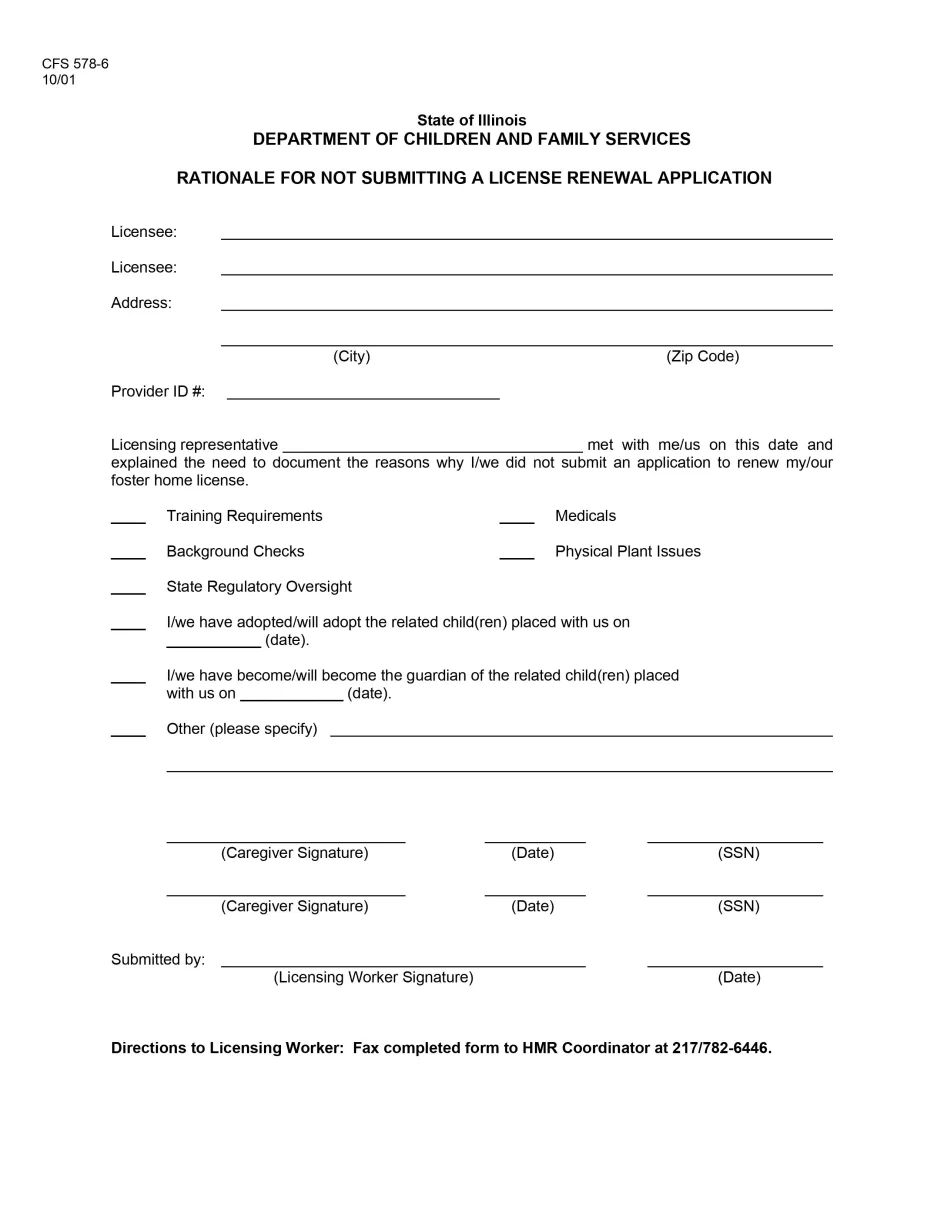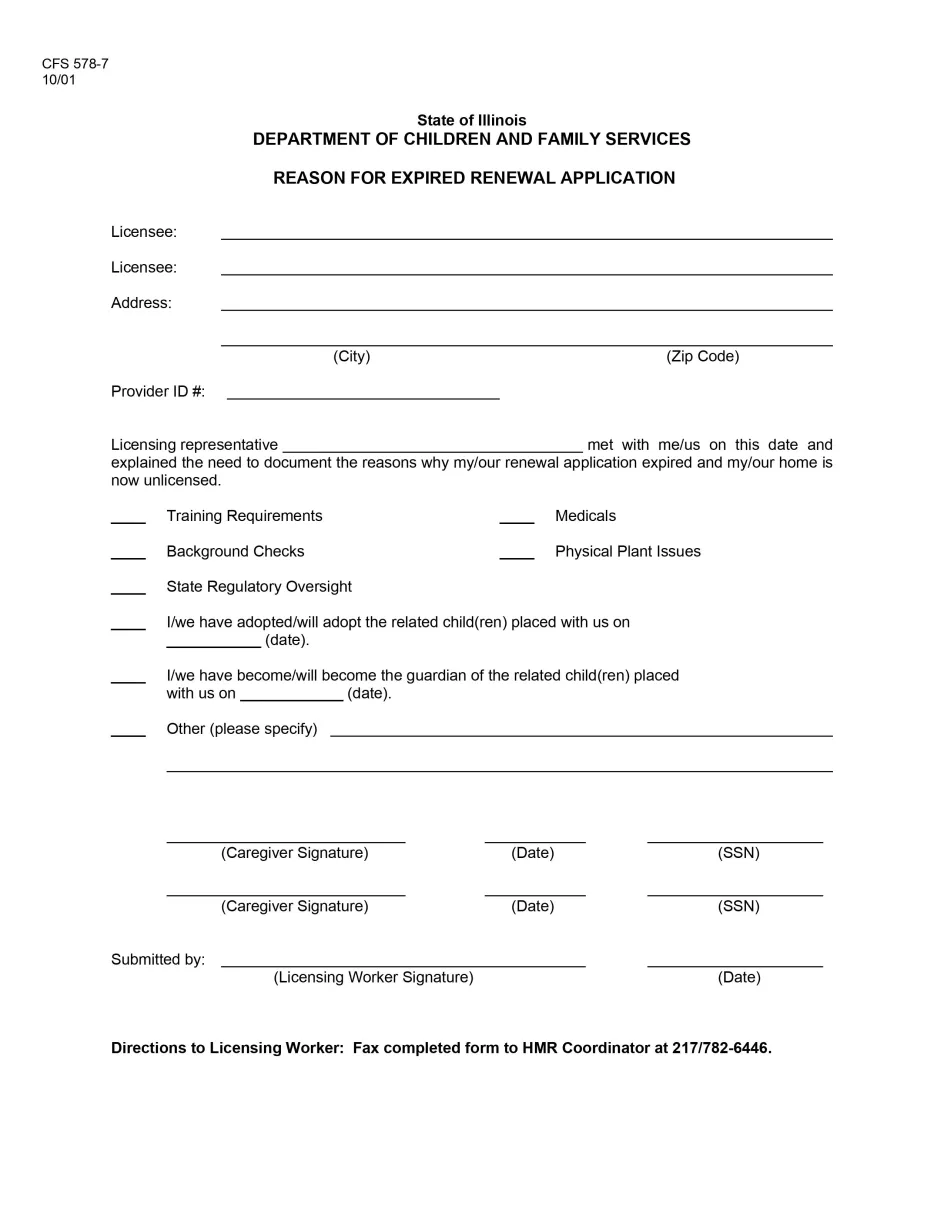- To: Rules and Procedures Bookholders, DCFS and Purchase of Service (POS) Child Welfare Workers, POS Licensing Staff and DCFS Family Development Workers and Child Protection Staf
- From: Jess McDonald
I. PURPOSE
The purpose of this Policy Guide is to issue instructions to staff for the initiative to increase the number of relatives that are licensed as foster family homes and to increase the number of children in relative care to achieve permanency.
II. PRIMARY USERS
The primary users of this Policy Guide are DCFS and purchase of service (POS) agency child welfare workers and licensing staff and DCFS child welfare and family development staff.
III. BACKGROUND
On July 3, 2001, the Administration for Children and Families of the U.S. Department of Health and Human Services released a policy announcement clarifying that states may no longer claim federal Title IV-E funds for the administrative costs associated with serving children in unlicensed relative care placements. This means a potential loss in the federal match for the cost of providing case management services to children placed with relatives who have not been licensed.
To minimize any loss of federal funds, the Department is implementing an initiative to increase the number of relatives who become licensed foster parents and to increase the number of children in relative care who achieve permanency. The initiative will be implemented in the Department and purchase of service agencies.
IV. DEFINITIONS
For purposes of this process, an “unlicensed relative” is a related caregiver who does not hold a valid foster home license or permit at the time the child is placed. It also includes licensed foster homes with related children in placement where the licensees become unlicensed because they surrender their license, or fail to submit a renewal application, or fail to complete the licensing process and the pending renewal application expires. The related caregiver may have had prior licensing history, but does not currently hold a valid license or permit.
“Clean-up group” means relative caregiver homes that are not licensed at the time that the Home of Relative Licensing and Permanency Initiative begins.
“On-going group” means relative caregiver homes that accept their first placement - - or the placement is data entered - - after November 1, 2001. This group also includes licensed foster homes with related children in placement where the licensees become unlicensed because they surrender their license, or fail to submit a renewal application, or fail to complete the licensing process and the pending renewal application expires.
“Licensing worker” means a POS licensing representative or a DCFS family development specialist.
"Complete application for foster family home license" means a completed written application form; written authorization by the applicant and all adult members of the applicant's household to conduct a criminal background investigation; medical evidence in the form of a medical report, on forms prescribed by the Department, that the applicant and all members of the household are free from communicable diseases or physical and mental conditions that affect their ability to provide care for the child or children; the names and addresses of at least 3 persons not related to the applicant who can attest to the applicant's moral character; and fingerprints submitted by the applicant and all adult members of the applicant's household. [225 ILCS 10/4]
“HMR Coordinator” means the Home of Relative Coordinator in the Central Office of Licensing. This individual is responsible for tracking assignments, resolving problems, and reporting progress to the Director and others.
V. PROGRAM IMPLEMENTATION
Each DCFS region and POS agency shall appoint a Home of Relative (HMR) Liaison to facilitate quick and consistent communication between the agency or region and the DCFS Central Office of Licensing (CooL). The CooL will appoint a staff person to serve as the HMR Coordinator.
- Clean-up Group Process
Clean-up Group Lists
The CooL HMR Coordinator shall forward to each region or POS agency contact person a list of the relative caregiver homes in the Clean-up Group by November 15, 2001.
A copy of each POS agency’s list will also be sent to the appropriate DCFS Agency Performance Teams (APT).
Assign Home to Licensing Worker
Within 3 business days of receiving the final Clean-Up Group list from the HMR Coordinator, the DCFS region or POS agency shall assign a licensing worker to the home.
Make Appointment for Home Visit
Within 5 business days of being assigned to the home, the licensing worker shall contact the related caregivers (by telephone whenever possible) and make an appointment for a home visit to discuss the benefits of getting licensed, explain the licensing process, and answer any questions the relative might have.
If the licensing worker is unable to contact the related caregivers by telephone, the licensing representative shall send a letter via certified mail to the related caregivers and maintain a copy of the letter.
The initial home visit shall occur no later than 10 business days after the licensing worker has contacted the caregivers to make the appointment, unless the related caregivers cannot meet sooner. If the visit does not occur within 10 days, the licensing worker shall document, in writing, the reason for the delay in the initial home visit.
- Make Initial Home Visit
Discussion/Explanation
During the initial home visit, the licensing worker shall discuss/explain the following:
- the caregivers’ role in becoming a permanency resource for the child(ren);
- the benefits of getting licensed (including the difference in payment);
- permanency options other than reunification that may become appropriate for the children (e.g., adoption and guardianship);
- licensing requirements, including space, background checks, health examinations, training; and
- the licensing process and timeframes, including what constitutes a “complete” application.
The licensing worker shall use the CFS 578-5, Comparison: Standard of Need vs. Foster Care Board Rate, to complete the CFS 578-3, Payment Comparison Worksheet to show the caregivers how much more money the caregivers would receive per month if they became licensed.
Determine Caregivers’ Interest in Licensure
The licensing worker shall help the caregivers make an informed decision about their interest/intention to go forward with the licensing process and shall help the caregivers complete and sign a CFS 578-1, Confirmation of Interest form.
If the licensing worker determines through the discussion and/or the initial walk through the home that the caregivers will not be able to meet licensing standards, the licensing worker should do the following:
- make every attempt to help the caregivers understand that they should check the “not interested in licensure” box on the CFS 578-1;
- explain that the Department does not provide any financial assistance to the caregivers to cover any costs that might be associated with changes to the caregivers, home that would be required to meet one or more licensing standards;
- give the caregivers a license application packet and help them through the licensing process if they insist on submitting an application for licensure; and
- help the caregivers to understand that they may still be suitable candidates to adopt or take guardianship of the child(ren) even though they may not be able to meet licensing requirements.
If caregivers check that they are interested in getting licensed, the licensing worker shall do the following:
- ensure that the caregivers record the name and SSN of each caregiver on the CFS 578-1; and
- give the caregivers a license application packet and explain the forms.
Send Completed CFS 578-1, Confirmation of Interest Form, to HMR Coordinator
Within 1 business day of making the initial home visit, the licensing worker shall fax the completed CFS 578-1 to the HMR Coordinator at 217/782-6446. The licensing worker shall keep a copy of the completed CFS 578-1 in the file.
Record Information on HR-01 Screen
Upon receipt of a completed CFS 578-1, the HMR Coordinator shall record the following information on the HR-01 screen:
- the date the form is received
- the caregivers’ decision (Yes or No)
Assist Caregivers Who Indicate Interest in Pursuing Licensure
For every home where the caregivers indicated an interest in pursuing licensure on the CFS 578-1, the licensing worker shall take all steps necessary to ensure that the caregivers and/or household members do the following:
- get fingerprinted; if necessary;
- get registered for - - and attend - - the earliest possible classes of the 6-hour Pre-Licensure Pride training (or a POS agency’s equivalent that has been approved by the Department); and
- submit a “complete” application (as defined in Rule 402 and Section IV of this Policy Guide
The licensing worker shall have weekly contact (by telephone and/or in-person) with the caregivers until the caregivers have submitted a “complete” application. If at any point in the process a caregiver decides to not continue the process, the licensing worker must have the caregiver complete a new CFS 578-1 and fax it within one business day to the HMR Coordinator at 217/7826446. A copy of the new CFS 578-1 shall be placed in the caregiver’s licensing file.
The licensing worker shall document all contacts with caregivers, including dates, in the licensing record.
- Register “Complete” Application in DCFS Data System
DCFS Applications
Upon determining that an application packet is “complete”, the DCFS licensing worker shall ensure that the “complete” application is registered/data entered. The application shall not be registered in the data system until the application is “complete” as defined in Section IV of this Policy Guide and in Rule 402.
The licensing supervisor shall ensure that the application is data entered such that the effective date of the “complete” application is the date the application was date-stamped into the licensing office.
The licensing supervisor shall ensure that the following documents are sent to CooL immediately:
- a completed CFS 506-F, Family Home Information form; and
- a completed/signed CFS 718, Authorization for Background Check for every applicant and household member age 13 and over (except the related children in placement).
POS Agency Applications
Upon determining that the application packet is “complete”, the POS agency licensing worker shall forward the “complete” application packet to CooL for data entry.
CooL data entry staff shall register the application in the data system. The effective date of the complete application is the date the application is date-stamped into CooL.
- Complete the Licensing Process
General
After the “complete” application has been received, reviewed, and registered in the data system, the licensing worker shall have at least semi-monthly (twice per month) telephone or in-person contact with the applicants to provide appropriate and necessary technical assistance and consultation and to ensure that the licensing process is completed. A recommendation to “issue license” or “deny license” (or “withdraw application” if appropriately documented as noted in #10, below) shall be submitted to the Central Office of Licensing.
The licensing worker shall document all contacts and activities, including dates, in the licensing record.
Indicate Placement Eligibility on ILS
Effective November 1, 2001, the foster home licensing worker making a recommendation to “issue license” must write one of the following statements on Page 2 of the ILS (next to the recommendation):
- Full training completed
- 6-hour Pre-Licensure training completed
If the licensing worker writes “Full training completed”, CooL will put the RU (for Related & Unrelated children) on the LC-02 screen
If the licensing worker indicates “6-hour Pre-Licensure training completed’, CooL will put the RO (for Related only children) marker on the LC-02 screen in the “License Description Field”
If the licensing worker fails to write either statement on the ILS, CooL will put the RO marker in the data system (and the home will be approved for related only placements (even if the licensees actually completed the full Foster PRIDE training and the 6-hours of Educational Advocacy training).
After receiving a license based on the 6-hours of PreLicensure training, the home will remain coded as RO until CooL receives an ILS on which the licensing worker has written the following statement: “Full training completed.” Upon receiving an ILS with that statement, CooL will change the RO on the LC-02 screen to RU.
Applicants Request Withdrawal of Application
If the applicants request that their application for licensure be withdrawn at any point in the licensing process prior to the licensing worker submitting a recommendation (to “issue license” or “deny license”) to CooL, the licensing worker shall do the following:
- document the request date;
- document the name of the applicant making the request;
- document the reason the applicant has requested that the application be withdrawn; and
- submit an ILS to CooL to “AW” (withdraw) the application with required documentation.
When such action occurs, CooL will data enter the withdrawal and the reason and that information will appear on the HR-01 screen.
The Office of Information Systems (OIS) will place the home on the next HMR Permanency Follow-up Report (see Section D).
Other Possible Dispositions of HMR Homes
A home will be removed from the HMR Licensing Follow-up Report when a “complete” application for licensure is submitted and data entered; however, the home’s progress in getting licensed will be tracked via the monthly Foster Care Caseload Reports that are sent out by CooL each month to DCFS foster home licensing workers and POS agencies until one of the following occurs:
- CooL finds an absolute bar to licensure/residence on an applicant or household member during the background check process and denies the application - - (the “license description code” on the LC-02 screen will show DB for “Denied/Bar”); or
- The licensing worker submits a recommendation to CooL to deny the application for any of the following reasons:
- applicants cannot meet licensing standards (“license description code” on LC-02 screen will show DS for “Denied/Standards”);
- applicants have failed to cooperate in or complete the licensing process (“license description code” on LC-02 screen will show DC for “Denied/Cooperation); or
- applicants or household members have non-bar criminal and/or CANTS history that renders the home unsuitable for licensure (“license description code” on LC-02 screen will show DH for “Denied/History”).
In these cases, CooL staff will enter the appropriate code on the LC-02 screen. The appropriate status code and date will then populate the HR-01 screen.
The Office of Information Systems (OIS) will place the home on the next HMR Permanency Follow-up Report (see Section D).
- Process for New Cases
Placing Worker Gives Caregivers an Application Packet
The worker who places a child in an unlicensed relative’s home shall give to the caregiver a standardized placement packet that contains the following items:
- Cover letter from Director McDonald :
- CFS 458, Relative Caregiver Placement Agreement;
- CFS 454, Placement Safety Checklist; and
- Brochure: What You Need to Know About Being a Relative Caregiver.
Caseworker In-Person Visit
When a child is placed with a relative caregiver who has no prior foster home licensing history and no other children placed in the home, the child’s caseworker shall make an in-person visit to the caregiver’s home within 5 business days of the Department receiving temporary custody of the child.
The purpose of the visit includes the following:
Assess the Child’s Adjustment
The caseworker should assess the adjustment of the child and caregiver to the child’s placement, including but not limited to determining whether the child or caregiver is experiencing any problems that require the caseworker’s attention and response.
Talk with Child
The caseworker shall talk with the child (if age and developmentally appropriate) about how he/she is feeling about living with the caregiver and how the child feels about not living with his/her parents. At a minimum the caseworker shall ask and talk about all the questions for the child listed in the “Child Adjustment” section of the CFS 578-2, New Relative Placement Practice Guide.
Talk with Caregiver about the Child’s and the Family’s Adjustment
The caseworker shall also talk with the caregiver about how she/he and other family members are adjusting to having the child placed with her/him and how the child is adjusting to the placement.
At a minimum, the caseworker should discuss with the caregiver all of the questions regarding the child’s adjustment listed on the CFS 578-2.
Regarding the caregiver’s adjustment to the child’s placement, the caseworker should discuss with the caregiver, at a minimum, all of the questions listed in the “Caregiver’s Adjustment to Child” section of the CFS 578-2.
Discuss Department’s Overall Possible Outcomes for the Child
The caseworker shall explain and discuss with the caregiver the outcomes that might occur for a child depending on the progress of the child’s parents in resolving the issues that caused the child to be unsafe at home.
At a minimum, the caseworker should discuss with the caregiver all of the questions regarding possible permanency outcomes listed on the CFS 578-2.
Discuss (Preliminarily) Benefits of Becoming Licensed Foster Parent
The caseworker shall discuss with the caregiver the amount per month the caregiver will receive for caring for the child as an unlicensed relative that is given on the CFS 578-5 , Comparison: Standard of Need vs. Foster Care Board Rate.
The caseworker shall also explain to the caregiver that she/he might want to consider becoming licensed as a foster parent because the Department’s payment to a licensed foster parent for caring for a child is substantially higher than the payment to a relative caregiver who is not a licensed foster parent. The caseworker shall complete with the caregiver the CFS 578-3, Payment Comparison Worksheet, to illustrate the payment differential.
Additionally, the caseworker shall give the caregiver a copy of the brochure What You Need to Know About Being a Relative Caregiver and inform the caregiver that a foster home licensing worker will contact the caregiver to schedule an appointment to further discuss foster home licensing requirements.
The caseworker shall document the discussion on the CFS 578-2.
In-home Visits
The caseworker shall continue to make an in-person visit to the caregiver’s home at least 2 times per month until it is determined that the caregiver does not want to pursue licensure as a foster home or it is determined by DCFS that the caregiver may not be licensed.
- Home Appears on HMR Licensing Follow-up Report
Send Report to Contact Person
Each month the HMR Coordinator shall send each DCFS region and POS agency an HMR Licensing Follow-up Report that is a cumulative list of unlicensed relative- caregivers who are still candidates for licensure because the caregivers:
- have not yet indicated that they are not interested in getting licensed via a CFS 578-1 ;or
- have indicated on a CFS 578-1 that they are interested in pursuing licensure but a “complete” application for licensure has not yet been data entered in the licensing system
The HMR Coordinator shall send a copy of each POS agency’s report to the appropriate APT unit.
Assign Licensing Worker
Within 3 business days of receiving the monthly HMR Licensing Follow-up Report from the HMR Coordinator, the DCFS region or POS agency shall assign a licensing worker to any relative home to which a licensing worker has not been assigned.
Make Appointment for Home Visit
Within 5 business days of being assigned to the home, the licensing worker shall contact the related caregiver – by telephone whenever possible – and make an appointment for a home visit to discuss the benefits of getting licensed, explain the licensing process and answer any questions the relative caregiver may have. If the licensing worker is unable to contact the related caregiver by telephone the licensing representative shall send a letter to the caregiver and maintain a copy of the letter.
The initial home visit shall be conducted no later than 10 business days after the licensing worker has contacted the caregiver to make an appointment unless the caregiver cannot meet within that time frame. The licensing worker shall document the reason for the delay in writing.
- Make Initial Home Visit
Discussion/Explanation
During the initial home visit, the licensing worker shall discuss/explain the following:
- caregivers’ role in becoming a permanency resource for the child(ren);
- benefits of getting licensed (including the difference in payment as outlined on the CFS 578-5, Comparison: Standard of need vs. Foster Care Board Rate chart);
- other permanency options that may (e.g., adoption and guardianship) be appropriate
- licensing requirements, including space, background checks, training, etc.; and
- licensing process and timeframes, including what constitutes a “complete” application.
Determine Caregivers’ Interest in Licensure
The licensing worker shall help the caregivers make a decision about their interest/intention to go forward with the licensing process and shall help the caregivers to complete and sign a CFS 578-1, Confirmation of Interest form (attached).
If the licensing worker determines through the discussion and/or the initial walk-through the home that the caregivers will not be able to meet licensing standards, the licensing worker should do the following:
- make every attempt to help the caregivers understand that they should check the “not interested in licensure” box on the CFS 578-1;
- explain that the Department does not provide any financial assistance to the caregiver to cover any costs that might be associated with changes to the caregiver’s home that would be required to meet one or more licensing standards;
- give the caregivers a license application packet and help them through the licensing process if they insist on submitting an application for licensure, anyway; and
- help the caregivers understand that they may still be suitable candidates to adopt or take guardianship of the child(ren) even though they may not be able to meet licensing standards.
If caregivers check that they are interested in getting licensed, the licensing worker shall do the following:
- ensure that the caregivers record the name and SSN of each caregiver on the CFS 578-1; and
- give the caregivers a license application packet and explain the forms.
Send Completed CFS 578-1, Confirmation of Interest Form, to HMR Coordinator
Within 1 business day of making the initial home visit, the licensing worker shall fax the completed CFS 578-1 to the HMR Coordinator at 217/782-6446. The licensing worker shall keep a copy of the completed CFS 578-1.
Assist Caregiver in Pre-Application and Application Activities
For every home where the caregivers checked “Yes” on the CFS 578-1, the licensing worker shall take all steps necessary to ensure that the caregivers and/or household members do the following:
- get fingerprinted; if necessary;
- register for - - and attend - - the earliest possible classes of the 6-hour Pre-Licensure Pride training (or POS agency’s approved equivalent).; and
- submit a “complete” application (as defined in Section IV of this Policy Guide).
The licensing worker shall have weekly contact (by telephone and/or in-person) with the caregivers until the caregivers have submitted a “complete” application. If at any point in the process a caregiver decides to not continue the process, the licensing worker must have the caregiver complete a CFS 578-1 and faxed within one business day to the HMR Coordinator at 217/782-6446. A copy is also to be placed in the caregiver’s licensing file.
The licensing worker shall document all efforts and contacts, including dates, in the licensing record.
- Register “Complete” Application in DCFS Data System
DCFS Applications
Upon determining that an application packet is “complete”, the DCFS licensing worker shall ensure that the “complete” application is registered/data entered. The application shall not be registered in the data system until the application is “complete” .
The licensing supervisor shall ensure that the application is data entered and that the effective date of the “complete” application is the date the application is date-stamped into the licensing office.
The licensing supervisor shall ensure that the following documents are sent to CooL immediately:
- completed CFS 506-F, Family Home Information, form; and
- completed/signed “Authorization for Background Check” form (CFS 718) for every applicant and household member age 13 and over.
POS Agency Applications
Upon determining that the application packet is “complete”, the POS agency licensing worker shall forward the “complete” application packet to CooL for data entry.
CooL data entry staff shall register the application in the data system so that the effective date of the complete application is the date the application was date-stamped into CooL.
- Complete the Licensing Process
General
After the “complete” application has been received, reviewed, and registered in the data system, the licensing worker shall have semi-monthly (twice per month) telephone or in-person contact with the applicants to provide appropriate and necessary technical assistance and consultation and to ensure that the licensing process is completed. A recommendation to “issue license” or “deny license” (or “withdraw application” if appropriately documented) shall be submitted to the Central Office of Licensing within 75 days of the “complete” application effective date.
The licensing worker shall document all contacts and activities, including dates, in the licensing record.
Indicate Placement Eligibility on ILS
Effective November 1, 2001, the foster home licensing worker making a recommendation to “issue license” must write one of the following statements on Page 2 of the ILS (next to the recommendation):
- Full training completed
- 6-hour Pre-Licensure training completed
If the licensing worker writes “Full training completed”, CooL will put the RU (for Related & Unrelated the LC-02 screen.
If the licensing worker indicates “6-hour Pre-Licensure training completed’, CooL will put the RO (for Related only children) marker on the LC-02 screen in the “License Description Field”
If the licensing worker fails to write either statement on the ILS, CooL will put the RO marker in the data system (and the home will be approved for related only placements (even if the licensees actually completed the full Foster PRIDE training and the 6-hours of Educational Advocacy training).
After receiving a license based on the 6-hours of PreLicensure training, the home will remain coded as RO until CooL receives an ILS on which the licensing worker has written the following statement: “Full training completed.” Upon receiving an ILS with that statement, CooL will change the RO on the LC-02 screen to RU.
Applicants Request Withdrawal of Application
If the applicants request that their application for licensure be withdrawn at any point in the licensing process prior to the licensing worker having sent a recommendation (to “issue license” or “deny license”) to CooL, the licensing worker shall do the following:
- document the request date;
- document the name of the applicant making the request;
- document the reason the applicant has requested that the application be withdrawn; and
- submit an ILS to CooL to “AW” (withdraw) the application.
When such action occurs, CooL will data enter the withdrawal and the reason and that information will appear on the HR-01 screen.
OIS will place the home on the next “HMR Permanency Follow-up Report (see Section D).
Possible Dispositions of HMR Homes
A home will be removed from the HMR tracking lists when a “complete” application for licensure is submitted and data entered; however, the home’s progress in getting licensed will be tracked via the monthly “Caseload Report” sent to each DCFS licensing worker and POS agency until one of the following occurs:
- CooL finds an absolute bar to licensure/residence on an applicant or household member during the background check process - - (the “license description code” on the LC02 screen will show DB);
- The licensing worker submits a recommendation to CooL to deny the application for any of the following reasons:
- applicants cannot meet licensing standards (“license description code” on LC-02 screen will show DS);
- applicants have failed to cooperate in or complete the licensing process (“license description code” on LC-02 screen will show DC); or
- applicants or household members have non-bar criminal and/or CANTS history that renders the home unsuitable for licensure (“license description code” on LC-02 screen will show DH).
In these cases, CooL staff will enter the appropriate code on the LC-02 screen. The appropriate status code and date will then populate the the HR-01 screen.
OIS will place the home on the next “Permanency Review List” (see Section D).
Transfer Licensing Responsibility for HMR Homes
Once licensing responsibility for a related caregiver home is assigned to a DCFS region or POS agency, the licensing responsibility for that home shall remain with the originally assigned DCFS region or POS agency unless transfer of that responsibility occurs as described below.
(Note: For information on how the initial assignment of licensing responsibility is determined, see Appendix A.)
Prior to Initial Visit by Licensing Worker and/or Submittal of CFS 578-1, Confirmation of Interest
If the region or agency with assigned licensing responsibility believes that all of its children have moved out of the home or that supervisory responsibility for the related children has been transferred to another agency/DCFS team, and the licensing worker has not yet made the initial home visit and/or submitted a completed CFS 578-1 to the HMR Coordinator , the assigned licensing worker shall maintain responsibility for:
• conducting the initial visit; and
• submitting the CFS 578-1 to the HMR Coordinator.Caregivers Indicate Not Interested in Licensure
If, during the initial visit, the caregivers indicate on the CFS 578-1 that they are not interested in getting licensed, the licensing worker shall fax the completed CFS 578-1 to the HMR Coordinator.
The HMR Coordinator shall record the following information on the HR-01 screen:
- date the completed CFS 578-1 was received;
- caregivers’ decision (N = Not Interested).
- Caregivers Indicate They Are Interested in Licensure
- Transfer Request Denied
Data System Does Not Confirm Movement/Transfer of Region’s or Agency’s Children
The HMR Coordinator shall immediately record the following on the CFS 578-4:
- the data system does not confirm that all of the children have been moved/transferred; and
- the transfer request is being denied.
The HMR Coordinator shall fax the CFS 578-4 form back to the licensing worker.
Data System Confirms All Children Have Been Moved or Transferred from Home
The HMR Coordinator shall immediately record the following on the CFS 578-4:
- the data system shows that there are no children remaining in the home;
- the request to transfer licensing responsibility is denied because the caregivers have indicated an interest in getting licensed and there is no other agency/region which should be assigned responsibility for continuing the licensing process with the caregivers; and
- the currently assigned licensing worker must continue the licensing process with the caregivers.
The HMR Coordinator shall fax the CFS 578-4 form to the licensing worker.
Transfer Request Granted
If the data system confirms that all of the region’s/agency’s children have been moved or transferred from the home - - - and that there are children from another region or agency remaining in the home - - - the HMR Coordinator shall do the following:
- complete the required data entry on the HR-01 screen to transfer licensing responsibility;
- determine the region or agency that will be given responsibility for continuing the licensing work with the caregivers and enter that information on the HR-01 screen;
- send written notification to the contact person for the originally assigned region/agency that informs the contact person of the following:
- the transfer request has been granted and the region/agency is no longer responsible for carrying out the licensing activities for the home;
- the identity of the new licensing entity (region/agency); and
- the contact person must ensure that the licensing worker who made the home visit sends a letter to the caregivers informing them that a different region/agency will be taking over licensing responsibility and identifying the new region/agency.
- send to the contact person for the newly assigned region/agency a copy of the completed CFS 578-1 and a memorandum that informs the contact person that:
- licensing responsibility for the home has now been assigned to the region/agency and the home will appear on the region’s/agency’s next monthly HMR Licensing Follow-up Report; and
- the contact person must ensure that the home is assigned to a licensing worker immediately and that the assigned licensing worker contacts the caregivers within 10 business days to introduce him/herself as the new licensing worker and continue the licensing process with the caregivers.
- Transfer Request Denied
After Submittal of the CFS 578-1 and Caregivers Are Interested in Getting Licensed
If the region or agency with assigned licensing responsibility believes that all of its children have moved out of the home or that supervision has transferred to another agency/DCFS team and the licensing worker has already submitted the CFS 578-1 to the HMR Coordinator, and the caregivers indicated on the CFS 578-1 that they were interested in getting licensed, the following steps shall apply:
• The licensing worker shall fax a completed CFS 578-4, Request to Transfer Licensing Responsibility, to the HMR Coordinator.
• The HMR Coordinator shall check the data system to determine if all of the assigned region’s or agency’s children have been moved/transferred.
Transfer Request Denied
The HMR Coordinator shall deny the request to transfer licensing responsibility for the home in the following situations:
Data System Does Not Confirm Movement/Transfer of Region’s or Agency’s Children
The HMR Coordinator shall immediately note on the CFS 578-4 that the transfer request is being denied because the data system does not confirm that all of the region’s or agency’s children have been moved/transferred from the home, and fax the form back to the licensing worker.
Data System Confirms No Children Remain in the Home
If the data system confirms that there are no children remaining in the home , the HMR Coordinator shall immediately note on the CFS 578-4 that the transfer request is being denied and the region or agency must maintain licensing responsibility and continue the licensing process with the caregivers because the caregivers have indicated an interest in getting licensed. The HMR Coordinator shall fax the CFS 578-4 back to the licensing worker.
Transfer Request Granted
If the data system confirms that all of the region’s/agency’s children have been moved or transferred from the home - - - and that there are children from another region or agency remaining in the home - - - the HMR Coordinator shall do the following:
- complete the required data entry on the HR-01 screen to transfer licensing responsibility;
- determine the region or agency that will be given responsibility for continuing the licensing work with the caregivers and enter that information on the HR-01 screen;
- send written notification to the contact person for the originally assigned region/agency that informs the contact person of the following:
- the transfer request has been granted and the region/agency is no longer responsible for carrying out the licensing activities for the home;
- the identity of the new licensing entity (region/agency); and
- the contact person must ensure that the licensing worker who made the home visit sends a letter to the caregivers informing them that a different region/agency will be taking over licensing responsibility and identifying the new region/agency.
- send to the contact person for the newly assigned region/agency a copy of the completed CFS 578-1 and a memorandum that informs the contact person that:
- licensing responsibility for the home has now been assigned to the region/agency and the home will appear on the region’s/agency’s next monthly HMR Licensing Follow-up Report; and
- the contact person must ensure that the home is assigned to a licensing worker immediately and that the assigned licensing worker contacts the caregivers within 10 business days to introduce him/herself as the new licensing worker and continue the licensing process with the caregivers.
- HMR Permanency Follow-up Report
General
Each month DCFS regions and POS agencies will receive an HMR Permanency Follow-up Report. The report will list children who are being cared for by a related caregiver who has indicated “No” on the CFS 578-1, Confirmation of Interest, or who the Department has determined may not be licensed as a foster home. The report will include, but not be limited to the following information: the child’s name and ID number; the name and ID number of the caseworker assigned to the child’s case; and the name and location address of the unlicensed relative caregiver.
A child’s name will appear on the HMR Permanency Follow-up Report twice: the first monthly report after the caregiver indicates on the CFS 578-1 that she/he is not interested in pursuing licensure or the Department determines the caregiver may not be licensed; and one additional monthly report after the monthly report on which a child’s name first appears.
Caseworker Follow-Up
It is not the Department’s intent to remove children from the care of an unlicensed relative caregiver. Conversely, it is important to assess a child’s safety and movement toward permanency.
Therefore, within 10 business days of receiving the HMR Permanency Follow-up Report on which the home first appears, the casework supervisor shall convene a family meeting. The purpose of the meeting is twofold:
- to assess the safety and well-being of the child(ren); and
- to assess progress toward achievement of permanency for the child(ren).
The outcome of the staffing could include the following:
- Child/Children Are Safe & Progress Toward Permanency Is Satisfactory -- No change in the placement of the child(ren) required.
- Child/Children Are Safe but Progress Toward Permanency Is Not Satisfactory -- Caseworker and supervisor shall discuss options or alternatives for achieving permanency, including but not limited to finding an alternative permanency placement for the child(ren).
- Child(ren) Are Not Safe & Progress Toward Permanency Is Not Satisfactory -- Caseworker and supervisor shall take any and all action necessary to ensure the safety of the child(ren), including but not limited to establishing a safety plan and/or removing the child(ren) from the caregiver’s home.
- Licensed Relative Caregivers Become Unlicensed
Licensees Surrender License
If CooL receives an ILS to “close/surrender” a foster home license, and there are still related children in the home , and the licensing worker has not documented the reason for the surrender , CooL shall return the ILS to the licensing worker to document the reason for the surrender. CooL will not process any requests to “close/surrender” a license with related children in the home until the reason for the surrender has been documented by the licensing worker.
CooL shall data enter the reason code on the LC-02 screen in the “License Description” field. It will populate to the HR-01 screen.
The name of any related child who is still placed with the caregiver will appear on the next monthly HMR Permanency Follow-up Report and the supervisor of the caseworker assigned to the child’s case will convene a child and family meeting as described In Section V. D. of this Policy Guide.
Licensees Fail to Submit a License Renewal Application
Every month, CooL shall check the monthly renewal report for the prior month to determine which foster home licensees failed to submit an application to renew the foster home license. CooL shall check the data system for each home to determine if there are still related children in placement.
If there are still related children in placement, CooL shall notify the licensing worker that he/she must do the following within 30 days:
- meet with the former licensees to ascertain the reason they did not submit an application for license renewal;
- have them complete a CFS 578-6, Rationale for Not Submitting a License Renewal Application; and
- fax the completed CFS 578-6 to the HMR Coordinator at 217/782-6446.
CooL shall data enter the reason code on the LC-02 screen in the “License Description” field. It will populate to the HR-01 screen.
The name of any related child who is still placed with the caregiver will appear on the next monthly HMR Permanency Follow-up Report and the supervisor of the caseworker assigned to the child’s case will convene a child and family meeting as described In Section V. D. of this Policy Guide.
Licensees’ Renewal Application Expires
Every month, CooL shall check the monthly report for the prior month to determine which foster homes have become unlicensed because the pending Renewal Application expired. CooL shall check the data system for each home to determine if there are still related children in placement.
If there are still related children in placement, CooL shall notify the licensing worker that he/she must do the following within 30 days:
- meet with the former licensees to ascertain the reason the pending renewal application expired;
- jointly complete a CFS 578-7, Reason for Expired Renewal Application; and
- fax the completed CFS 578-7 to the HMR Coordinator at 217/782-6446.
CooL shall data enter the reason code on the LC-02 screen in the “License Description” field. It will populate to the HR-01 screen.
The name of any related child who is still placed with the caregiver will appear on the next monthly HMR Permanency Follow-up Report and the supervisor of the caseworker assigned to the child’s case will convene a child and family meeting as described In Section V. D. of this Policy Guide.
VI. ATTACHMENTS
Attached to this Policy Guide are:
- Appendix A, Initial Assignment of Lead Licensing Responsibility
- Appendix B, Frequently Asked Questions and Answers
- CFS 578-1, Confirmation of Interest*
- CFS 578-2, New Relative Placement Practice Guide CFS 578-3, Payment Comparison Worksheet*
- CFS 578-4, Request to Transfer Licensing Responsibility
- CFS 578-5, Comparison: Standard of Need vs. Foster Care Board Rate
- CFS 578-6, Rationale for Not Submitting a License Renewal Application
- CFS 568-7, Reason for Expired Renewal Application
- These forms can be ordered in the usual manner. *These forms are also available in Spanish.
VII. QUESTIONS
Questions regarding this Policy Guide should be directed to the HMR Coordinator at 217/785-2688.
VIII. FILING INSTRUCTIONS
POLICY GUIDE 2001.16
APPENDIX A
INITIAL ASSIGNMENT OF LEAD LICENSING RESPONSIBILITY
Unlicensed relative caregivers were initially assigned to a DCFS region or a POS agency for the purpose of lead responsibility for licensing work based on the following approach:
- Current living arrangement type and type service code for children placed with caregiver;
- Verification that the caregiver resides in Illinois (ie. Out-of-state caregivers were excluded);
- Verification that the caregiver has no current licensing history (licensed, application pending or a pending renewal)
- Verification of which agency is getting paid for case management for the children placed in the home (i.e. who is associated for payment purposes with the provider ID number of the caregiver serving the child(ren) as recorded in the Department’s provider database If the “pay to” data element on the MARS PR 02 screen was blank, it was presumed that the caregiver was supervised by DCFS.
If only one agency is being paid, the home was assigned for the purpose of lead licensing responsibility to that agency.
If multiple agencies were involved in serving children placed with the caregiver, then the assignment of the home was determined by application of the following criteria:
- Past licensing history;
- Agency with the most children placed in the home;
- If case management of children in the home was equally split between involved agencies, the Agency serving the oldest child;
- If children in the home are the same age, the agency serving the child who has been in placement the longest.
The LAN in which the caregiver’s home is located was then determined by the Department using the caregiver’s mailing address:
- DCFS homes were assigned to the appropriate region and Licensing Team.
- POS Homes were assigned to the appropriate POS agency.
Each DCFS region and POS agency was asked to complete any necessary data clean-up of preliminary lists by no later than September 26, 2001. The cleanup included:
- Correcting as necessary caregiver (i.e. provider) information such as mailing or location address; and/or
- Correcting information concerning case management assignment of any child who is listed on the reports as being placed with the caregiver.
This data clean-up was essential because the Department produced in early October and distributed to all POS agencies and DCFS regions a “final” list of what will be referred to as the “clean-up” group of caregiver’s/homes. On all future unlicensed caregiver reports produced for DCFS and POS agencies, the “clean-up” group of caregivers will be identifiable by the date on which the caregiver first appeared on the report.
The list produced in early November 2001 will be the baseline for monitoring and measuring the performance of DCFS regions and POS agencies in successfully getting relative caregivers licensed as foster parents.
POLICY GUIDE 2001.16
APPENDIX B
HOME OF RELATIVE LICENSING AND PERMANENCY INITIATIVE
FREQUENTLY ASKED QUESTIONS AND ANSWERS
This document provides answers to frequently asked questions related to the Department Home of Relative Licensing and Permanency Initiative begun in State Fiscal Year 2002.
What procedures should an agency (DCFS or POS) follow if they think a relative caregiver has two different provider numbers?
A caregiver may have multiple provider ID numbers. A provider ID number may or may not have a child associated with that number that an agency (POS or DCFS) is supervising. For licensing purposes, the agency should use an ID number associated with one of the children for whom they are providing case management services.
Will the Department provide any financial assistance to relative caregivers to cover or offset any costs a caregiver might incur to meet foster home licensing standards?
The Department does not make any financial assistance available to cover or offset any costs a caregiver might incur to meet foster home licensing standards as described in DCFS Rule 402, Foster Family Home Licensing Standards.
Does the Department plan to make available more Spanish sessions of training required for licensure?
Yes. The Department provides training in Spanish whenever needed. A class can be scheduled whenever seven (7) or more participants are identified. Further, individual training can be scheduled to accommodate unusual circumstances. Agencies are advised to continue to use the current procedure: work with the local community college approved to provide Foster/Pride training by notifying them of the need for classes in Spanish. Please notify the Division of Training and Development Services by calling 217-785-5689.
Must licensing staff contact an unlicensed relative caregiver who is caring for only one child and the child is age 18 or older?
Yes. The caregiver must be contacted and must be given the opportunity to decide whether or not they want to pursue licensure as a foster home. The caregiver’s decision must be recorded on the “Confirmation of Interest in Foster Home Licensure” form and faxed to the Central Office of Licensing.
Some POS agencies have been approved by the Department to provide their own foster parent training rather than using the “Foster/Adopt Pride” training curriculum. What procedures should the POS agencies follow-up to revise their curriculum and obtain the Department’s approval?
Agencies will need to revise their current curriculum to accommodate the new changes in foster care provider training. These changes include:
- Pre-licensure foster care provider training must be the same for related and unrelated caregivers;
- Pre-licensure training must be limited to no more than six hours and must include the Foster Parent Handbook;
- Following licensure, both related and unrelated caregivers must participate in six hours of mandatory Education Advocacy;
- Additional pre-placement training is recommended for all. Each agency may design pre-placement training and/or additional support training covering required elements contained in Foster/Pride. Pre-placement or additional support training would be voluntary for the related caregiver. Unrelated caregivers would be required to attend the program designed and approved by the agency prior to accepting an unrelated child for placement;
- Related and unrelated caregivers are required to comply with continuing education requirements for renewal
In accordance with Rule 402, each agency is required to submit its revised training program for approval by the Department. Programs may be sent to the Division of Training and Development. The review is based on current best practice roles, responsibilities and requirements for all caregivers. The approval process will be expedited to accommodate current requirements.
Does DCFS intend to reduce the amount of administrative payment to POS agencies for children placed with unlicensed relatives?
No reduction in the administrative payment rate to POS agencies for children placed with unlicensed relatives is contemplated at this time. However, this decision may change in the future depending on an agency’s performance/compliance with established procedures governing licensing work with unlicensed relative caregivers.
Before the 1995 HMR reform effort, some current unlicensed relative caregivers completed 6hours of training that was required for the caregiver be approved as meeting licensing standards. Will these caregivers be required to complete the new 6 hours of pre-licensure training?
Yes, the caregivers will be required to complete the new 6 hours of licensure training if they choose to pursue licensure as a foster family home and serve related children. They will also have to complete 6 hours of training on educational advocacy within 12 months of becoming licensed.
If the licensed caregiver decides subsequently that she/he wants to also care for unrelated children, the caregiver will need to complete an additional 21 hours of training before being able to accept an unrelated child for care.Does the Department plan to send a letter to all unlicensed relative caregivers to inform them of the Department’s initiative?
Yes. The Department plans to send a letter to all unlicensed caregivers. The letter will be in English and Spanish. DCFS Regions and POS agencies will be notified when the letter is mailed and also will be provided a copy of the letter.
How frequently will caseworkers be expected to make an in-person visit to the home of an unlicensed caregiver?
The caseworker who has case management responsibility for a child who is placed with an unlicensed caregiver will be expected to make an in-home visit to the caregiver’s home at least twice a month until it is determined that the caregiver does not want to become licensed or that the caregiver cannot be licensed.
Will DCFS modify the actual foster home license to indicate on it whether a foster parent may care for related children only or for both related and unrelated children?
The Department has no plans to modify the actual foster home license. However, the Central Office of Licensing will maintain such information and provide it the Department’s Placement Clearance Desk (PCD).
PCD staff will use the information as part of the process by which it approves or disapproves a child’s placement.
Will any changes be made to the Individual License Summary (ILS) due to this initiative?
No changes to the ILS are contemplated
Will the changes being made regarding the number of hours of training required before licensure or the number of hours required before being able to care for an unrelated child have any impact on the training requirements for a person who is adopting an unrelated child for whom DCFS has no legal responsibility?
No
What do I do if a child is on my report for whom we are no longer providing case management services?
Call the appropriate regional 906 Hotline/business office or Cook County Case Assignment Placement Unit (312-808-5160) to verify the placement changes have occurred and the child is NO longer your responsibility.
What do I do if a home is on my report and all of the children have moved to a different foster home?
Call the appropriate regional 906Hotline/ business office or the Cook County Case Assignment and Placement Unit (312-808-5160) to verify the move to the new placement has occurred.
What do I do if a home is on my report and I think it is licensed or has an application pending in process?
Call the HMR Coordinator in the Central Office of Licensing at 217-785-2688 to confirm the licensing status of the caregiver.
What do I do if a home is on my report and I don’t know the caregiver or any of the children?
Call the Central Office Client Payment Unit at 217-525-0499, Option 2 for resolution.
What do I do if we have children on different provider ID numbers on the report?
Nothing should be done. This does not create any problem(s).
What if the name of the caregiver on the report is incorrect or is spelled wrong?
Call the Central Office Client Payment Unit in Springfield at 217-525-0499, Option 2. They will correct the spelling and may request that the caregiver complete, sign, and submit a new “Request for Taxpayer Identification and Certification (W-9 form).
What if the address of the caregiver is incorrect?
Call your regional 906 business office or Case Assignment and Placement Unit (Cook County) to have the location address changed. They will need to know if the new address is where they want their mail to be sent.
What is the advantage of my adopting or becoming a guardian of my teenage relatives?
If the child is adopted or guardianship is finalized by June 30, 2002 and the child is at least 14 years old but not yet 18 at finalization, upon emancipation from adoption or guardianship the Department will pay the child $500 per month for 6 months for a total of $3,000 to begin their independence.
If the relative child has not been in foster care for two years, how can I obtain guardianship?
The guardianship rules have recently changed. The child has to be in DCFS custody for a year and in your care for a year to qualify for subsidized guardianship.
What if a caregiver is on my list with 2 different social security numbers or the social security number is not correct?
Validate which social security number is correct and call The Central Office Client Payment Unit at 217-525-0499 option 2 for the correction. CPU will correct the data system and will mail a “Request for Taxpayer Identification and Certification (W-9 form) to the caregiver for completion and submittal back to the Department.
Will a relative who gets licensed as a foster home be able to care for a related child who has been determined by Level of Care procedures to require a specialized care and receive a higher payment for providing care to the child?
Yes, provided that the child’s eligibility for specialized care has been determined according to the Department’s Level of Care approval procedures as contained in Policy Guide 2001.03.
Does a related caregiver have to do anything more than get 6 hours of training to qualify for a license?
Yes! The relative caregiver will have to meet all of the requirements for foster home licensure, i.e., comply with the standards in Rule 402, Licensing Standards for Foster Family Homes.
